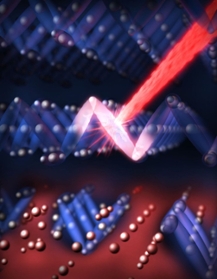Jul 30 2013
An international team of researchers, which includes UvA physicists Hermann Dürr and Mark Golden, has clocked the speed limit for electrical switching in magnetite (Fe3O4), a naturally magnetic mineral. Their results could drive innovations in the tiny transistors that control the flow of electricity across silicon chips, enabling faster, more powerful computing devices.
 An optical laser pulse (red streak from upper right) shatters the ordered electronic structure (blue) in an insulating sample of magnetite, switching the material to electrically conducting (red) in one picosecond. (Credit: Greg Stewart, SLAC National Accelerator Laboratory.)
An optical laser pulse (red streak from upper right) shatters the ordered electronic structure (blue) in an insulating sample of magnetite, switching the material to electrically conducting (red) in one picosecond. (Credit: Greg Stewart, SLAC National Accelerator Laboratory.)
Using the SLAC National Accelerator Laboratory’s Linac Coherent Light Source (LCLS) X-ray laser, the researchers found that it takes only 1 picosecond (or a trillionth of a second) to flip the on-off electrical switch in samples of magnetite, which is thousands of times faster than the most advanced transistors currently in use. The LCLS experiment also showed researchers how the electronic structure of the sample rearranged into non-conducting ‘islands’ surrounded by electrically conducting regions, which began to form just a few hundred femtoseconds (hundreds of quadrillionths of a second) after a laser pulse struck the sample. The study, which was published in the prestigious journal Nature Materials, shows how such conducting and non-conducting states can coexist and create electrical pathways in next-generation transistors.
Ultra-fast switching
In the experiment, scientists first hit each sample with a visible-light laser, which fragmented the material's electronic structure at an atomic scale, rearranging it to form the islands. The laser blast was followed closely by an ultra-bright, ultra-short X-ray pulse from the LCLS that allowed researchers to study, for the first time, the timing and details of changes in the sample excited by the initial laser strike. By slightly adjusting the interval of the X-ray pulses, they precisely measured how long it took the material to shift from a non-conducting to an electrically conducting state, and observed the structural changes during this switch.
The Verwey transition
Scientists had worked for decades to resolve this electrical structure at the atomic level, and just last year another research team had identified its building blocks as ‘trimerons’, which is formed by three iron atoms that lock in the charges. That finding provided key insights in interpreting results from the LCLS experiment. Magnetite was chosen as a relatively simple member of a large family of materials known as complex oxides. These systems display a wide range of electronic and magnetic properties that are both of fundamental interest and also offer exciting possibilities as active materials in a 'post-Moore' electronics era. Below minus 150 Celsius, magnetite undergoes the Verwey transition, transforming from a good electrical conductor (the 'on' state) to an insulating state in which the charges and orbitals are frozen into a locked-in pattern (the 'off' state). In their experiments, the scientists cooled their magnetite crystals to minus 190 degrees Celsius, so as to lock its electrical charges in place prior to the pump-laser pulse. Future experiments will aim to identify exotic compounds and test new techniques to induce the switching and tap into other properties that are superior to modern-day silicon transistors. The SLAC researchers have already conducted follow-up studies focusing on a hybrid material that exhibits similar ultra-fast switching properties at near room temperature, which makes it a better candidate for commercial use than magnetite.
Novel materials for tomorrow's computers
According to Hermann Dürr, who is the principal investigator of the LCLS experiment and professor by Special Appointment of Ultrafast X-Ray Science at the University of Amsterdam’s Faculty of Science, there is a global effort underway to move beyond modern semiconductor transistors using new materials to satisfy demands for smaller and faster computers. According to him, the LCLS has the unique ability to hone in on processes that occur at the scale of atoms in trillionths and quadrillionths of a second. Dürr is joining Golden and a number of other Dutch physics groups in a consortium to compete for funding to take this kind of research to the next level, combining the strong complex oxide thin film expertise in the Netherlands with the unique capabilities of the LCLS. While magnetite's basic magnetic properties have been known for thousands of years, the experiment shows how much still can be learned about the more exotic electronic properties of magnetite and other more complex materials using LCLS, said Dürr.